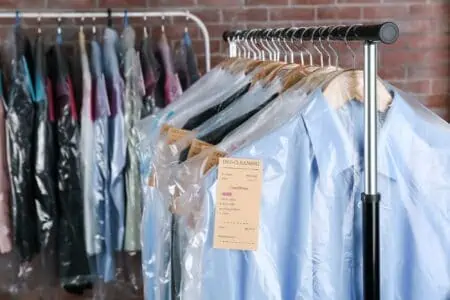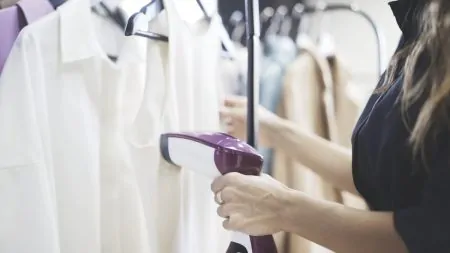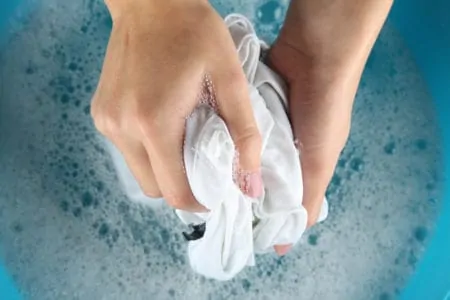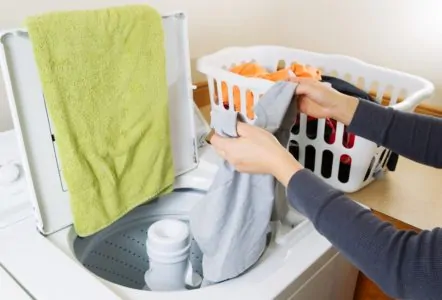Dry cleaning can seem like this magical, other-worldly job somebody else does for us. But have you ever wondered what actually happens to your clothes when you drop them off at the dry cleaners?
We’ve got 20 amazing dry cleaning statistics and facts to share. Whether you want to know more about the industry, the trends, or the future of dry cleaning — we’ve got you covered.
Top 10 Dry Cleaning Statistics and Facts
- The dry cleaning and laundry services market size was 8.9 billion dollars as of 2018.
- The biggest stakeholder in the dry cleaning market is the Asia Pacific.
- Trends are changing to suit the current culture. More dry cleaning places are using better appliances that are more efficient and eco-friendly.
- More laundry services offer a contactless option to avoid paying by cash.
- There were around 94,000 dry cleaner employees in the US as of 2022.
- The average wage for dry cleaners in the US is $27,630 annually.
- In the US, 68.7 percent of dry cleaners are white, 14 percent are Black, and 12.9 percent are Asian.
- At-home dry cleaning kits are becoming more popular because they are an affordable alternative.
- More places will use laundry mobile apps so customers can check on the status of their clothes and browse available services.
- People are dressing more casually, so experts worry that there will be less demand for dry cleaning services.
Market Analysis for Laundry Businesses
If you’re into industry facts, then we have some insightful data to share. This information is all about laundry and dry cleaning businesses, the market size, and more.
- The market size: As of 2018, the global revenue for dry cleaning and laundry services was 8.9 billion dollars (1). Experts predict it will reach 79.91 billion by 2027.
- What drives the market?: More people are using dry-cleaning businesses because they offer an expert service that’s quite affordable.
- Dry cleaning still uses liquid: Dry cleaning isn’t 100 percent dry. If you’ve been wondering how dry cleaning works, the cleaners use a liquid solvent called tetrachloroethylene (referred to as perc). The reason it’s called “dry” cleaning is because they don’t use water — just the solvent.
- Global market segmentation: The Asia Pacific is the biggest stakeholder in the dry cleaning market. This is due to countries’ expanding economies and a more significant working population. Europe is also growing in its demand for dry cleaning services, mostly due to more disposable income.
- Key players: The key global players in the dry cleaning market include Alliance Laundry Systems LLC, the Huntington Company, and ZIPS Dry Cleaners.
Dry Cleaning Industry Trends 2022
When you imagine laundry services, you probably think of a large room with many washing machines and an old TV playing in the background.
Not only is this a boring environment, but the appliances are usually outdated and inefficient. What are some of the fun trending dry cleaning industry statistics?
- Better appliances and cleaners: People are more conscious of their carbon footprint and how their actions affect the environment. Many laundry service businesses are upgrading their appliances to more efficient, inexpensive, and eco-friendly alternatives.
- More entertainment while you wait: In some situations, it’s not worth heading out to work while you wait for some laundry. Instead, staying at the laundromat is more practical, especially if you can bring your laptop. Advanced laundromats have Wi-Fi and entertainment for kids so that adults can hang around while their clothes get clean.
- Pick-up and drop-off: More places offer pick-up and drop-off services for those who can’t make it to the dry cleaners. This is great for busy families or people with disabilities.
- No more cash: More places have contactless payment options. This minimizes spreading germs but also makes payment easier for customers.
- Wash and fold: While many services have done this for a while, folding clothes is a significant current trend. Clothes are now ready to be put away, which saves you time after a busy working day.
Dry Cleaner Demographics
Let’s learn a little more about the people who dry clean your clothes. What are they like? Who are they? Where do they work? What do they earn? Let’s find out.
- Number of employees: In the US, there were 93,953 dry cleaner employees as of 2022 (2). Surprisingly, that’s 8.6 percent less than there were in 2017.
- The average wage: Those in the dry cleaning and laundry service industry have an annual mean wage of $27,630 (3). That’s $13.38 per hour.
- Busiest states: The states with the highest dry cleaning employment levels include California, Texas, Florida, New York, and Ohio. In order, the best paying states are California, the District of Columbia, then Washington. The annual mean wage in California is $33,950.
- Employed dry cleaners by gender: A survey found that 46.8 percent of dry cleaner and laundry workers were women (4).
- Employed dry cleaners by race: The same survey found that 68.7 percent were white, 14 percent were Black, and 12.9 percent were Asian.
Future of the Dry Cleaning Business
Since our research found that dry cleaning profits are on the rise, but employee numbers are declining, we were intrigued. We took a look at what the future dry cleaner statistics and facts could be.
- At-home dry cleaning kits: While dry cleaning services are affordable for many, there’s a cheaper way to go about it. Home dry cleaning kits are becoming a bit more popular.
Our top recommendation is the Woolite kit. Avoid harsh chemicals, remove stains, tackle odors, and avoid shrinking your clothes with this easy-to-use product. - Eco-friendly dry cleaners: Currently, most commercial dry cleaners use harsh and hazardous solvents to clean your clothes. But as people demand greener alternatives, we will see more environmentally conscious dry cleaning businesses.
- Laundry mobile apps: The brand Tide predicts that in the near future, more businesses will use apps to connect with their customers (5). These apps will make it easy to book services, choose from a range of cleaning options, and help with easier access. Plus, customers will be able to see updates on their cleaning process in real time.
- Less contact with real humans: The pandemic has made everybody uber-conscious about germs. The future of dry cleaning may be that when you drop off and pick up your clothes, there won’t be any need to communicate with an actual human. Instead, you might find 24-hour lockers where you can drop off and pick up your clean and folded garments.
- People dressing more casually: With more people than ever working from home after COVID, casual dress codes are the way forward. With this change, people aren’t wearing their fancy, “dry-clean-only” clothing. This could lead to a significant drop in the need for dry cleaning services.









